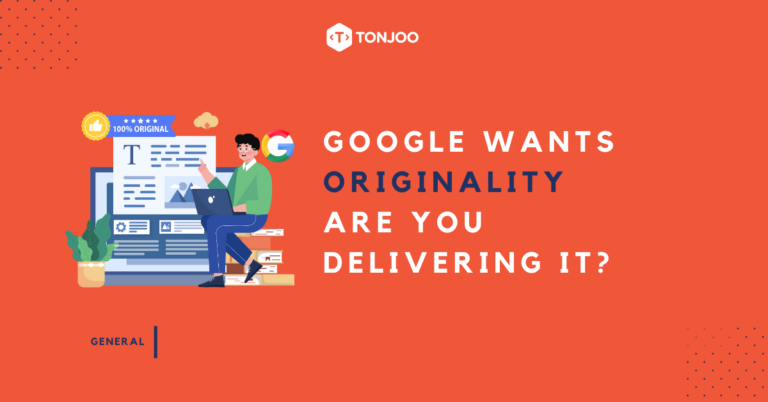
Google has made one thing very clear. It doesn’t just want content. Instead, it wants original content. Not rephrased and not patched together from other sites.
However, originality isn’t about “writing differently.” It’s about creating work so distinct in insight and execution that Google sees it as irreplaceable. That’s where many fail, because they confuse rewriting with originality. But Google can tell the difference, and your readers can too.
In this blog, we will explore what originality is, how Google detects it, and how you can avoid it. Let’s dive in!
Table of Contents
Why Google Is Obsessed with Originality?
Google’s mission is simple: surface the most valuable, trustworthy, and unique answers to search queries. But here’s the issue: its index is flooded with duplicates. Thousands of articles recycle the same talking points. And many don’t add a single new perspective.
Users notice it instantly. And the bounce rates rise when users see repetitive content. That’s a problem for Google’s credibility. So it’s refining its algorithms to spot what’s fresh and remove what’s recycled.
Three reasons originality now matters more than ever:
- User Trust Drives Rankings. Google prioritizes sources that build authority by contributing fresh perspectives.
- AI Content Overload. With tools pumping out reworded material at scale, Google’s filtering is getting stricter.
- Ranking Volatility. Sites relying on rehashed info are the first to vanish in core updates.
If your content is indistinguishable from ten others, Google sees no reason to rank you.
What Counts as Originality in Content?
Originality isn’t just about using your own words. It’s about contributing something others can’t or haven’t provided. Google values originality in multiple ways:
- Original Data: Surveys, proprietary research, or your own case studies show that you’re not just repeating information, but providing original data to readers.
- New Perspectives: Explaining a topic from a viewpoint most writers overlook adds uniqueness.
- First-hand Experience: Google’s EEAT framework rewards content created by those with real, documented experience in the subject.
- In-Depth Context: Covering angles others miss. Not surface-level summaries, but deeper layers that add meaning.
- Clear, Distinct Voice: A recognizable writing style makes your work memorable and identifiable to both readers and algorithms.
How Google Detects Unoriginal Content?
Google’s detection is more sophisticated than most people think. It’s not just looking for word matches. It’s analyzing:
- Information overlap: How much of your content’s factual substance matches others.
- Entity coverage: Which people, places, brands, and concepts you include, and in what sequence.
- Semantic fingerprints: Patterns in how information is organized and explained.
- Link references: Whether your outbound citations all point to the same sources that everyone else is using.
This means even if you “rewrite” every sentence, Google can still detect that your work mirrors existing material.
Why Most Content Isn’t Original Enough?
Creators often believe they’re producing unique work simply because they’ve worded it differently. The reality? Ninety percent of it is still built from second-hand knowledge.
Three common traps in this regard include:
- Topic Saturation: Choosing popular keywords and producing another “10 Tips” article without adding unique insight.
- Template Writing: Following identical structures for every post, creating predictable, low-differentiation content.
- Shallow Research: Pulling from the first page of Google without exploring deeper sources.
Yes, this approach might work for a short while. But it’s not suitable for long-term success.
How to Deliver Originality Google Can’t Ignore?
Start with Unanswered Questions
Most content creators rush toward high-volume keywords without asking a critical question: has this been explained to death already? You can’t stand out if you’re just rephrasing what 20 other pages already say.
Therefore, instead of using this practice, start by identifying where the conversation is thin. Search the topic and notice where users are still asking follow-up questions. Moreover, use “People Also Ask” on Google, scan Quora, check Reddit discussions, or even read comment sections on competitor blogs.
The gaps are where you’ll find opportunity. Build your article around answering what no one else has fully addressed, not just the main keyword itself. This ensures you’re adding something missing, not duplicating what’s already there.
Build from Primary Sources
If you want true originality, don’t rely on blog posts or Wikipedia pages. Instead, go straight to the source. Read the actual research paper, not the article summarizing it. If it’s industry data, pull from the original dataset. If it’s a trend, get quotes directly from professionals working in that field.
This approach gives you unfiltered, raw material that others can’t replicate by browsing the top search results. The bonus? You’ll find nuances, overlooked facts, and even contradictions that become the backbone of unique commentary.
Add Proprietary Insights
Original data is powerful, but so is your personal experience. If you’ve tested a method, built a process, or run an experiment, document it and add it to your content. Proprietary insights make your content irreplaceable because they can’t be Googled anywhere else.
For example, instead of repeating “Email subject lines should be short,” share the open rates you achieved from 20 campaigns, along with the exact subject lines used.
Change the Lens
Sometimes originality isn’t about new facts but about framing old facts in a way no one else has tried. This is where creativity meets research.
Let’s say you’re covering cybersecurity for small businesses. Most articles will talk about tools and checklists. You could approach it as “lessons small businesses can learn from casino security teams,” drawing parallels between two very different industries. Or frame a social media strategy by comparing it to urban street performance.
Changing the lens makes your content unpredictable, which is a key marker for originality. Readers enjoy fresh analogies, and Google’s algorithms also pick up on the novelty of the associations.
Go Deeper, Not Broader
Broad coverage is easier to replicate and often too shallow to hold authority. Instead, pick one narrow aspect and explore it thoroughly. If your topic is “SEO audits,” don’t list every checklist item in brief. Walk the reader through exactly how to conduct a link profile analysis, including specific tools, sample data interpretation, and potential pitfalls.
That level of detail creates a resource people bookmark and share because it genuinely helps them execute. Google rewards this type of depth because it signals high expertise and real usefulness.
Integrate Visual Proof
Text alone can’t always prove you’ve done the work. Adding original visuals like screenshots, process photos, and annotated charts immediately shows your involvement with the subject matter. This isn’t about stock images or generic graphics. It’s about content-specific proof.
For instance, if you’re explaining a workflow, show it in action on your screen. Similarly, if you’re writing about analytics, include your real dashboard data with sensitive details blurred.
Visual proof builds credibility and trust, which feeds directly into Google’s perception of your authority.
Check Plagiarism
Even if you’ve written every word yourself, unintentional similarities can happen, especially when covering common industry topics. Phrases, facts, or sentence structures might match existing work without you realizing it. That’s why a plagiarism check is a non-negotiable final step.
Use a reliable plagiarism checker to scan your draft before publishing. If matches appear, rewrite those sections with fresh structure or add original commentary that changes the value of the content. This isn’t just about avoiding legal trouble. It’s about protecting your credibility and ensuring Google sees your work as truly unique, not a duplicate hidden under different wording.
Why Originality is Your Long-Term SEO Strategy?
Algorithms will keep changing. AI-generated content will keep multiplying. But one constant remains, Google’s need for sources it can trust to deliver unique value.
If your content is genuinely original, every update becomes an advantage. Competitors relying on rewording will fade, while your work earns links, shares, and rankings that last years instead of weeks.
The shift is simple in theory but hard in practice. However, remember the simple thing: Stop creating to fill space and start creating to lead conversations.
Final Thoughts
Originality isn’t just a ranking signal; it’s your survival strategy in a saturated, AI-heavy content environment. Google isn’t punishing creators; it’s rewarding those who respect their audience enough to bring something new.
If you want your site to stand out, you can’t afford to be an echo. You must be a source. That means every piece you publish should answer a question, solve a problem, or reveal a perspective no one else has delivered in quite the same way.
Updated on August 22, 2025 by Admin Tonjoo


